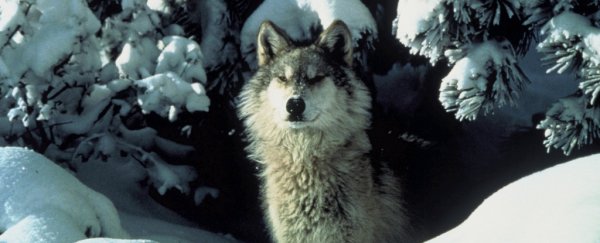Humanity has always had an uneasy relationship with wolves. They loom large in our ancient mythologies as fearsome beasts; over the millennia, that fear has led to devastation of wolf populations across Europe, including 19th century Germany.
In the 1960s, numbers of wolves (Canis lupus) in Europe hit an all-time low, veering perilously close to the brink of extinction. But in recent years they've been gradually coming back to Germany; now, new research has found they are assisted by an unlikely ally - the German military.
That assistance is not, mind you, on purpose. There have actually been several contributing factors to wolf populations growing by 36 percent annually, including the implementation of laws in the 1980s and 1990s to protect wildlife, along with a slow increase in wild ungulate numbers across Europe, resulting in more food for the wolves.
Still, there is an interesting correlation. Ilka Reinhardt, a biologist and wolf expert with LUPUS, the German Institute for Wolf Monitoring and Research, noticed something peculiar about the canine predators creeping back into Germany's forests.
Wolves moving into new areas settled first in military training areas (MTAs). Without exception.
Only once wolves had initially settled into those unfenced military areas did they move into surrounding territories nearby, outside the military area. But if they moved a long distance away, they would, once again, choose a military area to establish the initial territories.
It seemed like an odd coincidence, especially since specially designated protected areas should have been attractive to the animals. Reinhardt and her team started investigating it and found that the military training areas had a lower rate of wolves killed by humans - even more than protected areas (PAs).
In particular - there's less poaching on military land, and fewer wolves die at the hands of poachers in military areas compared to non-military areas. That contrast could be down to how these regions are managed.
"One key difference between military training areas and other areas, including protected areas, is the hunting regime," the researchers wrote in their paper.
"In Germany, hunting on MTAs is supervised by federal authorities and is managed across large areas, whereas PAs and other areas usually are divided in private hunting grounds with a minimum size as small as 75-150 ha. This may lead to situations where a wolf pack shares its territory with more than 100 hunters which, in turn, make these territories more vulnerable to poaching even if most hunters do not poach."
Military training areas are well documented as places where wildlife tends to thrive, serving as refuges in a landscape dominated by humans. However, their role as a stepping stone in the recolonisation of wolves had not been examined or recognised.
As we have since discovered, the presence of wolves is a net positive for various ecosystems. In the Yellowstone National Park, returning wolves has helped restore balance to the region, where wild elk had started to reach destructive numbers.
Conversely, the quaking aspen colony called Pando is under threat from grazing animals after humans decimated their natural predators to make the forest safer for tourists.
In Germany, things are looking up for the canines. According to the latest data, there are around 73 wolf packs and 60 wolf pairs in the country, Science Magazine reports - a dazzling increase since 2001, when the first litter of wild pups since the 19th century was reported.
But the role of military training areas is an important one to note. As the study cautions, attention should be paid to ways to maintain their status as wildlife refuges after they are taken out of military use.
"What is really remarkable is that the military areas acted as a stepping stone for the recolonisation," Guillaume Chapron, a wildlife ecologist at Swedish University of Agricultural Sciences in Uppsala, told Science.
"It shows that when you strictly protect wildlife, it comes back."
The team's research has been published in the journal Conservation Letters.
